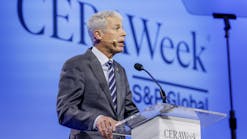Methane emissions from gas production lower than EPA estimates, study says
Researchers from the University of Texas at Austin said their direct measurements at 190 natural gas drilling sites found lower methane emissions than the US Environment Protection Agency has suggested in earlier estimates.
The UT measurements summary found wells generally emitted about 20% less greenhouse gases than EPA had estimated. Proceedings of the National Academy of Sciences published the study, “Measurements of methane emissions at natural gas production sites in the United States” on Sept. 16.
UT chemical engineering professor David Allen and other researchers measured methane emissions from shale gas wells completed with hydraulic fracturing. The study results released so far involved only the gas extraction phase.
Allen said the information will help policymakers make informed decisions. Meanwhile, more work is pending on other possible industry sources of methane emissions, such as pipelines.
Sponsored by the Environmental Defense Fund and natural gas producers, the study concluded that methane emissions from the development of gas and associated liquids represent 0.42% of total production.
Large oil companies contributed financing to the study. They include Anadarko Petroleum Corp., ExxonMobil Corp., Pioneer Natural Resources Co., and Royal Dutch Shell PLC.
Meanwhile, Physicians, Scientists & Engineers for Healthy Energy called the study “fatally flawed” because of the sample size and industry influence. But UT researchers said their methodology was sound and the research was done independently.
Trade associations last year reported in a joint study of their own that EPA estimates on methane emissions from unconventional gas production were too high (OGJ, July 2, 2012).
Industry reacts
The American Petroleum Institute said the UT study’s findings demonstrate industry’s successful efforts to reduce GHG emissions.
Howard Feldman, API director of regulatory and scientific affairs, said industry will continue making progress to reduce emissions voluntarily and in compliance with EPA’s recent emissions standards. “Capturing methane is helping operators deliver more natural gas to consumers, creating a built-in incentive to continue reducing these emissions,” Feldman said.
He emphasized the study results help show that additional regulation on top of existing federal, state, and local regulations are not necessary.
“In fact, safe and responsible development of energy from shale has helped the US cut carbon dioxide emission to near 20-year lows.” Feldman said.
Erica Bowman, vice-president of research and policy analysis for America’s Natural Gas Alliance, also welcomed the study results.
“We are continually putting into operation equipment and practices that demonstrate our commitment to lower emissions in the production process,” Bowman said. “We look forward to working with stakeholders to ensure the best science is applied in future study of this issue.”
EDF said the report marked the first of 16 methane emissions studies in a comprehensive initiative. The study marks what EDF calls “the opening chapter in this broader scientific effort designed to advance the current understanding of the climate implications of methane emissions resulting from the US natural gas boom.”
Fred Krupp, EDF president, acknowledged that “immediate methane reductions are critical to slow climate change,” adding, “But we don’t yet have a handle on how much is being emitted. We need better data, and that’s what this series of studies will deliver.”
He said new EPA wellhead emission regulations are effective. The overall research effort started last year to measure methane emissions associated with gas production, gathering lines and processing facilities, long-distance pipelines and storage, local distribution, and commercial trucks and refueling stations.
Various scientific methods are being used across the various studies, including approaches that measure emissions directly at the source and those that use airplanes or towers equipped with sensors to measure total emissions in a given area.
EDF anticipates all will be submitted for publication in peer-reviewed journals. The overall effort is scheduled to be completed in late 2014.
Study findings
The initial study report noted that findings showed higher emissions from pneumatic controllers and equipment leaks than EPA emission estimates. There was significant geographic variability in emissions from pneumatic pumps and controllers, researchers said.
The 190 onshore gas sites used for measurements involved the Gulf of Mexico coast, Rocky Mountains, and Appalachian regions.
Emission measurements were performed for 27 well completion flowbacks, 9 liquids unloadings, 4 well workovers, and 150 production sites of which 489 wells involved hydraulic fracturing.
“One important result from the measurements…is that current EPA estimation methods overpredict measured emissions,” the study said in its findings on unloadings. “There are multiple methods of unloading a gas well, some of which do not result in emissions.”
The UT-led study involved sampling performed for unloadings in which an operator manually bypassed the well’s separator.
Researchers said the overall implication is “a large uncertainty” in the national emissions from gas well unloadings. “It is also clear from the data that properly accounting for unloading emissions will be important in reconciling emission inventories with regional ambient measurements.”
Contact Paula Dittrick at [email protected].

Paula Dittrick | Senior Staff Writer
Paula Dittrick has covered oil and gas from Houston for more than 20 years. Starting in May 2007, she developed a health, safety, and environment beat for Oil & Gas Journal. Dittrick is familiar with the industry’s financial aspects. She also monitors issues associated with carbon sequestration and renewable energy.
Dittrick joined OGJ in February 2001. Previously, she worked for Dow Jones and United Press International. She began writing about oil and gas as UPI’s West Texas bureau chief during the 1980s. She earned a Bachelor’s of Science degree in journalism from the University of Nebraska in 1974.


